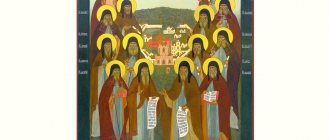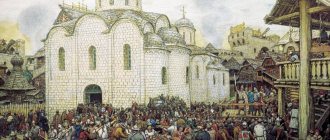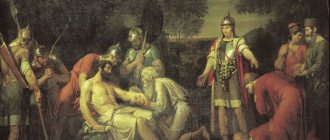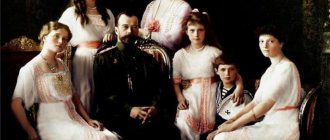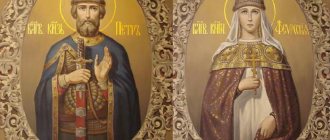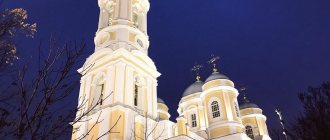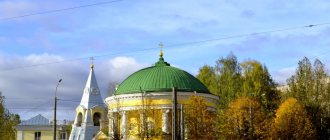Euphrosyne Kolyupanovskaya is one of the outstanding ascetics of the Russian Orthodox Church, who renounced the world for the sake of serving the Lord and accepted the difficult cross of foolishness. The saint came from a noble family and was close to many noble people, but she chose to leave secular society forever. Christians venerate the blessed one every year on July 16 and October 8.
Early life and renunciation of the world
Little information has been preserved about the life that Euphrosyne led before devoting herself entirely to God. The real name and surname of the Saint is Evdokia Grigorievna Vyazemskaya. The future holy fool was born into a princely family around 1758.
The young princess was educated at the Educational Society for Noble Maidens of the city of St. Petersburg. A young lady with good manners was able to achieve the high favor of Empress Catherine II and become one of her ladies-in-waiting.
It is not known exactly how long Evdokia Vyazemskaya was at court. Here she managed to meet many historical figures - commander Alexander Suvorov, Prince Yuri Dolgorukov and others.
Over time, the luxurious surroundings, palace gossip and intrigue began to oppress the young woman, and she began to think more and more often about serving the Lord. One day Evdokia decided to escape. Together with her, two more court girls, whose souls gravitated towards God, left the palace - Martha and Solomiya.
There are two known versions of how exactly the ladies-in-waiting left the imperial environment. According to the first, they waited until summer and during the court's stay in Tsarskoye Selo they staged a drowning in a pond. In order to be considered dead, the girls left their clothes on the shore of the reservoir, then changed into peasant dresses and fled.
The second story tells that three ladies-in-waiting simply left the palace. The young ladies were wanted for a long time in all corners of the country. One day, Evdokia, despite her attire, was recognized and returned to court. The Empress was not angry with the former maid of honor and greeted her kindly. Having learned about the girl’s firm determination to carry the prayer cross, she released her, finally giving her a new monastic dress.
Escape
No one remembers the exact date of this incident, but one day Princess Evdokia simply disappeared. Her dress was found on the shore of the pond. Most likely, this was an attempt to convince possible pursuers that she had drowned. But the fugitive failed to escape. The Empress gave the order to detain the princess. While being transported across one of the rivers, the police officer recognized her, after which Evdokia Grigorievna was returned to the capital. Catherine II received the fugitive kindly. After questioning, the reason for the escape became clear, and, convinced of the firmness of the former maid of honor’s intention to devote herself to God, the Empress sent her into the monastery, presenting her with a monastic dress made of shiny fabric. Perhaps Catherine wanted in this way to express hidden evil irony about Evdokia’s unexpected choice.
Life in the Vvedensky Monastery
After renouncing worldly life, Evdokia Vyazemskaya’s wanderings lasted about 10 years. Being a princess by birth, she did not disdain unusual work.
For some time, the former maid of honor worked in the barnyard of the Spaso-Sumorino Monastery. In 1806, she met with Metropolitan Plato, who gave the woman a blessing to accomplish the feat of foolishness. Under the name of “the fool Euphrosyne” she ended up in the Serpukhov Vvedensky Monastery.
After living for some time in the quarters for the sisters, the new novice moved to a small house not far from the monastery. After this, Euphrosyne began to surprise everyone around her with her unusual actions:
- lived with several cats and dogs, with whom she slept next to her on the floor;
- in cold weather she wore a man’s sheepskin coat, and on holidays she wore a gray cloth caftan;
- she always cut her hair short and tied a rag around her head;
- she flatly refused to wear shoes and remained barefoot even in severe frosts;
- I didn’t light the stove in winter, but did it during the scorching heat.
Secretly from everyone, the holy fool wore around her neck a heavy iron chain with a large cross, chains that pacified the flesh. When one landowner became aware of this, the old woman categorically forbade the disclosure of her secret.
During the day, the holy fool collected medicinal herbs in the forest next to the convent, and at night she walked around it and sang sacred psalms. Euphrosyne prayed in the chapel and went to the cathedral for the liturgy. She confessed to the confessor of the monastery, and received communion only with the onset of Maundy Thursday. During her life at the Vvedensky Monastery, Euphrosyne saw Metropolitan Philaret of Moscow several times, who was able to discern in her a great ascetic.
EUPHROSYNIIA KOLYUPANOVSKAYA
(Vyazemskaya Evdokia Grigorievna; ca. 1758 - 07/3/1855, village of Kolyupanovo, Aleksinsky district, Tula province), bl. (memorial on July 3 and September 22 - in the Cathedral of Tula Saints), Aleksinskaya, Tula. For the first time, information about E.K. was collected and published by her confessor, rector c. in honor of the Kazan Icon of the Mother of God. Kolyupanova, Tula province. priest Pavel Prosperov (see: DB. 1862. Issue 28), in 1911 I. M. Surikov compiled her biography.
Metropolitan Filaret (Drozdov) blesses the blessed one. Euphrosyne. Painting c. Kazan Icon of the Mother of God in the Kolyupanovsky Monastery. Beginning XXI century Photo. 2008 Metr. Filaret (Drozdov) blesses the blessed one. Euphrosyne. Painting c. Kazan Icon of the Mother of God in the Kolyupanovsky Monastery. Beginning XXI century Photo. 2008
Vyazemskaya graduated from the St. Petersburg Smolny Institute (belonged to the 1st graduating class), was a maid of honor at the court of the Emperor. Catherine II. She was friends with the families of A.V. Suvorov, Prince. Yu. V. Dolgorukova, as well as with his wife from the Kaluga province. leader of the nobility of the king. Vyazemskaya. Soon Vyazemskaya, together with other maids of honor, M. Ya. Sonina († August 10, 1805, buried in the Euphrosyne Monastery in Suzdal) and the maiden Salome († May 10, 1809, buried in the Moscow Simonov Monastery), under the influence of unknown circumstances, secretly left palace in Tsarskoe Selo, leaving her dress on the shore of one of the ponds and changing into peasant clothes. Vyazemskaya lived at churches and monasteries, baked prosphora, worked in the barnyard in the Sumorino monastery in honor of the Transfiguration of the Lord. In 1806, she came to Moscow and asked Metropolitan for a blessing for the feat of foolishness. Moscow and Kolomna Plato (Levshin). The Metropolitan blessed Vyazemskaya and, under the fictitious name of “fool Euphrosyne,” sent a handwritten letter to the Serpukhov Bishop in honor of the Entry of the Most Holy Theotokos into the Temple of the convent to the abbot. Dionysia (1806-1815). E.K. settled first in the sister’s building, and then in a cramped hut not far from the monastery, on the site of the monastery cellars. She did not cook anything, did not go to the sister’s meal, and took only bread and kvass from the monastery kitchen. According to legend, when Napoleon's army approached Moscow in 1812, the French. The troops stopped near the Vladychny Monastery. The officers discovered the ascetic’s house, began to insult her and mock her, but when in response they heard an accusation in the purest French. language, left.
Revered by Elder E.K., at first occasionally, and later. received visitors more often. During the drought, she begged for abundant rains and generous harvests. According to the stories of visitors, E.K. wore chains and a cloth hair shirt, a copper necklace and a chain with a cross around her neck, which her husband wore in winter. sheepskin coat, walked barefoot. I never cleaned the hut; I kept 2 cats and 3 dogs, chickens, and turkeys in the room. She slept reclining on the floor with the dogs, and when asked why she lived like this, she answered: “I’m worse than dogs.” Moscow abbot. Evgenia (Ozerova) once asked E.K. why she kept animals, which caused a “bad” smell in her home. The blessed one replied that this smell replaced the perfume that she used so much at court. Metropolitan Moscow and Kolomna St. Filaret (Drozdov), visiting the Bishop’s monastery, had a long conversation with E.K. in her house. It was E.K. who blessed the blessed one for the feat of foolishness. John of Tula. E.K. loved to pray in the chapel located near the monastery, and came to the monastery church for the liturgy (Rozhdestvensky V.L. Historical description of the Serpukhov Vladychny monastery for girls. M., 1866. P. 67). She received communion once a year on Maundy Thursday and confessed to the monastery confessor. On the feast of the Epiphany of the Lord, the blessed one went with a procession of the cross, performed from the Serpukhov Cathedral on the river. Naru. At the end of the prayer service, E.K., barefoot, in a cloth hair shirt, plunged into the consecrated water and, emerging from it, said to those around her: “Go, guys, hot bath, go, wash!”
Prayer of the Blessed One Euphrosyne at the source. Painting c. Kazan Icon of the Mother of God in the Kolyupanovsky Monastery. Beginning XXI century Photo. 2008
Prayer of the Blessed One Euphrosyne at the source. Painting c. Kazan Icon of the Mother of God in the Kolyupanovsky Monastery. Beginning XXI century Photo. 2008
By struggling in prayer, E.K. acquired the gift of clairvoyance. The blessed one repeatedly visited the family of the Serpukhov merchant G.V. Plotnikov. One day Plotnikov left for Moscow, and E.K., coming to his wife Agrippina, insistently repeated: “Cry, cry.” It soon became known that the merchant, returning from Moscow, died in Podolsk. In 1838, the blessed one gave the widow the Vladimir Icon of the Mother of God with images of Moscow Saints Alexy, Peter and Jonah (by 1917 this icon was kept in Serpukhov in the Plotnikov family).
In 1845, due to oppression from the new abbess of the Vladychny Monastery, E.K. moved from Serpukhov to located on the right bank of the river. Oki s. Kolyupanovo, Tula province. The local landowner N.A. Protopopova built a house for her, but the blessed one settled her dogs and cats in it, while she herself labored in a closet. She gave all the food brought to her to domestic animals, eating only what was left of them.
E.K. was spiritually nourished by the priest who served in the Kolyupanovsky Kazan Church (consecrated on February 4, 1783). Pavel Prosperov (later tonsured a monk with the name Pavlin, died on October 30, 1899 in the Trinity-Sergius Lavra). Several For years, E.K. received visitors who came to her for advice and with requests for prayer. She often visited the manager of the Myshega iron foundry, A.I. Tsemsh, who built a secluded cell for the blessed one in his garden. Residents of the place. The mice turned to E.K. for advice and were gladly welcomed into their homes. E.K. predicted the beginning of the Crimean War (1853-1856) and the defense of Sevastopol (1854-1855), state. the 1848 coup in France, which put an end to the reign of Cor. Louis Philippe, and the restoration (1852) of the empire by Napoleon III. In 1850, in a conversation with Protopopova, E.K. predicted the imminent appointment of bishop to the Tula and Belev departments. Dimitry (Muretov). In 1851, during his first trip around the diocese, the bishop visited the village. Kolyupanovo, Kazan Church, visited Protopopova. One day the old lady warned Protopopova: “Guests will arrive for dinner... The abbess is coming.” Indeed, on that day a novice from the Sezyonovsky monastery in Tambov province arrived in Kolyupanovo. Evfiya Morgacheva, post. abbess (see Seraphima (Morgacheva)).
Cancer over the relics of the blessed one. Euphrosyne in c. Kazan Icon of the Mother of God in the Kolyupanovsky Monastery. Photo. 2008
Cancer over the relics of the blessed one. Euphrosyne in c. Kazan Icon of the Mother of God in the Kolyupanovsky Monastery. Photo. 2008
E.K. loved to retire to a deep ravine on the banks of the Oka, 1 verst from Kolyupanov. Near the Proshenka River, which flowed along the bottom of the ravine, the ascetic dug a small well and, when the sick turned to her for help, she said: “Take water from my well and you will be healthy.” Hieroschim, who labored in the Kaluga diocese. Gerasim (Bragin-Martynov) recalled that in his youth he and his father often fished in the Oka and near the village. Kolyupanova saw an old woman praying.
On June 29, 1855, a few days before the death of the ascetic, Protopopova asked bishop. Tula Dimitri (Muretov) “to allow, in the event of the death of the old woman, to bury” her in a rural church. “The way of life and the hundred-year Christian feat brought her out of the ranks of ordinary worldly people, and I dare not leave it on my conscience to bury her body in a common cemetery, considering this matter not pleasing to God.” The blessed one was buried on July 7, 1855, with a large crowd of admirers under the refectory of the wooden Kazan Church, near the north. walls, in monastic vestments (the circumstances of E.K.’s tonsure are unknown). The burial was performed by 6 priests. Over the grave on the initiative of the priest. Paul, a wooden tomb with a cast-iron slab was erected, on which, with the blessing of the Moscow St. Philaret (Drozdov) inscribed: “Unknown Euphrosyne. God has chosen the turmoil of the world, let him put to shame the wise.” In 1914, a wooden canopy with gilding was built over the tomb; an icon, according to legend, which belonged to the blessed one, was also kept here. Since Aug. In 1884, before the liturgy, memorial services for E.K. were served in the Kazan Church, and healings were performed. By decree of the Tula spiritual consistory of November 7. In 1909, a special book was opened at the church, where cases of healings through prayers to E.K. were recorded.
In 1885, a wooden canopy chapel on pillars was erected over the fossilized E.K. spring, and in 1909, a wooden chapel covered with iron and a wooden bathhouse attached to it. Every year, on the day of the Descent of the Holy Spirit, a religious procession was held to the “Mother’s Well.” In 1931, the Kazan Church burned down, the burial and the well were in disrepair.
E.K. was honored by M.I. Tsvetaeva’s sister, Anastasia Ivanovna. While in Siberia. exile, A.I. Tsvetaeva rewrote the biography of the ascetic, drew her portrait and recalled the healing of a sore throat through prayers to E.K. as a miracle. At the end of her exile in 1959, Tsvetaeva found the miraculous spring and E.K.’s grave in the Tula region. and afterwards I came there many times.
In 1988, on the initiative of Archbishop. Tula and Belevsky Maxim (Krokha) E.K. was canonized as a saint of the Tula land. The service, akathist, troparion, and kontakion were compiled. In 1993-1996 on the site of the wooden Kazan Church that burned down in 1931. A stone temple of the same name was erected, in which a marble shrine was placed on the left side above the burial of E.K., with an icon of E.K. on it. Numerous healings were performed from the relics and on the source dug by the ascetic. Icons of E.K. are available in the All Saints Cathedral of Tula (a portrait painting in monastic vestments) and other churches of the diocese. The ascetic is also depicted on the icons of the Cathedral of Tula Saints.
In the 50s XIX century in conversations with the priest. P. Prosperov E.K. predicted that a monastic monastery would arise in Kolyupanov. July 16, 1995 at the Kazan Church. The Kazan Icon of the Mother of God convent was established.
Lit.: Elder Euphrosyne // DB. 1862. Issue. 28; Parishes and churches of the Tula diocese. Tula, 1895. P. 50; Tula EV. 1908. Part unofficial. No. 31. P. 597; Surikov I.M. Biography of the ascetic and seer of the blessed old woman Euphrosyne, the holy fool for Christ's sake, prince. Vyazemskaya, maid of honor to the Emperor. Catherine II. Serg. P., 1911; Tsvetaeva A.I. About miracles and the miraculous. M., 1991; Biography of the blessed one. Elder Euphrosyne. M., 2002.
D. B. Kochetov
Moving to Kolyupanovo
In 1845, the blessed one moved to the village of Kolyupanovo, located in the Tula province. The saint arrived here at the invitation of the landowner Natalya Protopopova, who was her admirer. The old woman took nothing with her except the prayed icon.
Some sources report that the main reason for the holy fool’s move was harassment from the new abbess of the Vvedensky Monastery. There is information that this woman harmed Euphrosyne in every possible way and even ordered all her dogs to be killed.
Mother stayed in Kolyupanovo for the last 10 years of her life. Here she was provided with a small separate house, but the prayer book preferred to live in a cramped room for the maid. As before, there were several animals in the room with her, which the old woman never cleaned up after. They also built a cell for the Blessed One, where she could stay for several months at a time. At Euphrosyne’s request, there was no furniture in this hut; it was replaced by a coffin, in which the old woman loved to rest.
Sometimes the Saint went to her admirers and stayed with them for a long time. Despite her advanced age, Euphrosyne most often traveled on foot. Less often, she rode in a wagon with some of her pets.
Healings and prophecies
During the years of the holy fool's stay in Kolyupanov, her ability to heal the sick was revealed. Mother relieved ailments with prayers, herbs, and also water from a well, which she dug with her own hands. The healing spring is still located in a ravine on the banks of the Oka, where the blessed one often prayed in solitude. This spring became famous throughout Russia. The water from it helped many local residents and visitors to recover from illnesses.
During her life in Kolyupanov, the holy fool cured many local residents.
- The landowner Protopopova, who sheltered the blessed one, suffered from hemoptysis and leg disease. After Euphrosyne advised her to wash herself in a bathhouse, in the stove of which there was a cauldron with horse manure, the woman was able to fully recover.
- One day a small child in the village fell ill. The holy fool came to his house herself, without an invitation, and brought medicinal herbs with her. The parents preferred to treat the baby with pills, but after that he became much worse and stopped walking. The father of the sick baby asked Euphrosyne for forgiveness and promised to follow all her instructions. The old woman read her prayers, gave the baby medicinal plants that saved him from death and put him back on his feet.
- The holy prayer book provided assistance to many women in labor. When one local woman could not give birth to a child within three days, the mother advised rubbing her with a special remedy and promised a safe birth after the first strike of the bell. Soon everything happened exactly like this.
The blessed prophetic gift was manifested in her ability to clearly see future events and describe them in detail. A story has been preserved about how Euphrosyne predicted one of the novices her appointment as abbess, and also prophesied a quick career growth for Bishop Dimitry Muretov.
The old woman was able to foresee her own death. A few weeks before her death, Euphrosyne had a prophetic dream in which angels called her to heaven. Mother informed those around her of her approaching death. After this, a large stream of people rushed to her to say goodbye and receive a blessing. In memory of herself, Euphrosyne gave people crosses, icons, clothes, and medicinal herbs.
During her lifetime, the Saint was also able to see events that were to happen many years later. So, she repeatedly said that a convent would be built at the site of her burial.
Holy spring
Natalya Alekseevna built a separate house for the holy fool, but Euphrosyne settled a cow in it, and for herself she chose the smallest room where the servants lived. Most likely, my mother spent her whole life asking God for forgiveness for the secular period of her life. The blessed one prayed in a ravine on the river bank. There, in the ravine, an almost ninety-year-old old woman dug a well with her own hands, the water from which she asked everyone who turned to her for healing to drink.
Perhaps, thus, allegorically, the saint suggested that in order to be healed from any illness, one must first of all have faith in Christ. The one who believes will be cured by the simplest remedy, even ordinary clean spring water from a source. The Gospel is that same holy source. Those who “drink” from it do not get sick. After all, illness is a consequence and indicator of damage to our souls.
Completion of life's journey
Blessed Euphrosyne gave her soul to God on July 3 (16), 1855. The old woman met death calmly. At about three o'clock in the afternoon she took communion, then folded her arms and died. The holy fool was buried as she had ordered - in full monastic vestments, with a cypress cross and rosary in her hands.
Many people were present at the farewell to my mother. Her body was buried inside the wooden Kazan church, under the floor of the refectory, for which permission was given by Bishop Demetrius of Tula and Belevsky. In 1988, Euphrosyne was canonized and canonized as a saint of the Tula land.
After her death, the old woman continued to show her bright miracles to believers. Water from the well she once dug still saves from various ailments. In the 20th century, an extraordinary case was recorded - the healing of a child blind from birth, whom his parents dipped into a sacred spring three times.
The memory of Euphrosyne Kolyupanovskaya remains in the hearts of many creative people. The blessed one was deeply revered by Anastasia Tsvetaeva, who was the poetess Marina Tsvetaeva’s sister. This woman personally created a portrait of the Saint and rewrote her life. According to Anastasia’s stories, prayers to the old woman more than once helped her get rid of illnesses.
The temple where Blessed Euphrosyne was buried existed until 1929. During the period of persecution for the faith, it was destroyed, and in 1931 it was completely burned. Despite these tragic events, people believed that mother’s prediction about the construction of a women’s monastery would come true. The words of the prayer book were destined to come true: today, at the site of her burial stands the Holy Kazan Monastery, the construction of which began in 1993.
Literature
- Kushelev-Bezborodko. Monuments. 1862. T. 4. P. 172-179;
- Dubrovsky M., priest. Life of St. Euphrosyne, prince. Polotsk, with a brief description of the women she founded in Polotsk. mon-rya. Polotsk, 1885;
- Sapunov A. Life of Euphrosyne of Polotsk. Vitebsk, 1889;
- [Nicodemus, Hierom.]. Akathist to Our Reverend Mother Euphrosyne, Princess of Polotsk. B. m., [1911];
- Service for the transfer of the venerable relics of our venerable mother Euphrosyne, Princess of Polotsk from the city of Kyiv to the city of Polotsk. St. Petersburg, 1911;
- Kaygorodov N. O. About the memorable St. Euphrosyne days in Polotsk on May 20-23, 1910: Vosp. pilgrims // Polotsk-Vitebsk antiquity. Vitebsk, 1912;
- Life of St. Euphrosyne, abbot. Polotsk. Transfer of relics. Modern miracles. Minsk, 1998;
- Life of Euphrosyne of Polotsk / Prepared by. text: E. Dorokhova // Lives and miracles of saints in ancient Russia. writing: Texts. Research Materials / Comp., article: M. S. Krutova. M., 2000. P. 153-173;
- St. Euphrosyne, abbot. Polotsk: Life and Akathist. Minsk, 2000
- Serbinovich K. S. East. information about the life of St. Euphrosyne, Princess of Polotsk, with a description and image of the cross she brought as a gift to the Polotsk Spassky Monastery. St. Petersburg, 1841;
- Klyuchevsky. Old Russian Lives. P. 262;
- Barsukov. Sources of hagiography. Stb. 176-179;
- Dimitry (Sambikin). Monthsword. May. pp. 130-134;
- Golubinsky. History of the RC. T. 1/2. pp. 597-601;
- aka. Canonization of saints. pp. 223-233;
- Villager E. St. Euphrosyne, prince. Polotsk. St. Petersburg, 1910, 1996;
- Titov F.I., prot. St. Euphrosyne, Princess of Polotsk: East. certificate for the upcoming transfer of the relics of St. Euphrosyne from Kyiv to Polotsk. K., 1910;
- Anthony (Melnikov), archbishop. St. Euphrosyne of Polotsk // BT. M., 1972. Sat. 9. P. 5-14;
- Voronova E. M. Life of Euphrosyne of Polotsk // SKKDR. Vol. 1. pp. 147-148;
- Macarius. History of the RC. Book 2. pp. 315-316;
- Orlov V. A. Euphrosyne of Polotsk. Minsk, 1992;
- Seregina N. S. Russian chants. saints St. Petersburg, 1994. pp. 122-133, 340-349;
- Alekseev L.V., Makarova T.I., Kuzmich N.P. The cross is the guardian of the whole universe: The history of the creation and reconstruction of the cross of St. Euphrosyne, abbot. Polotsk Minsk, 1996;
- Podskalski G. Christianity and theological literature in Kievan Rus (988-1237) / Trans. with him. St. Petersburg, 1996. pp. 239-240;
- Shalina I. A. Our Lady of Ephesus - Polotsk - Korsun - Toropetsk: Ist. names and archetype of the miraculous icon // Miraculous icon in Byzantium and Others. Rus'. M., 1996. P. 200-236;
- Melnikov A. A. Rev. Euphrosyne of Polotsk. Minsk, 1997;
- Yanin V.L., Gaidukov P.G. Certificate seals Dr. Rus' X-XV centuries. M., 1998. T. 3. P. 41, 127;
- Monastery near the c. Spasa: Polotsk Spaso-Euphrosinievsky Monastery from antiquity to the present day. Minsk, 2000;
- Nazarenko A.V. Ancient Rus' on international routes: Interdisciplinary essays on cultural, trade, political relations of the 9th-12th centuries. M., 2001 (by decree);
- Kloss B. M. Euphrosyne of Polotsk (1104-1173): Venerable, founder of 2 monasteries // Ist. lexicon: History in persons and events of the V-XIII centuries. M., 2006. Book. 1. pp. 479-484;
- Euphrosyne of Polotsk. Minsk, 2007;
- Monastery near the Church of the Savior: Polotsk Spaso-Euphrosinievsky Monastery from antiquity to the present day. Minsk, 2007. pp. 3-34, 56, 75, 76
What can you ask the Saint for?
First of all, Orthodox Christians turn to Blessed Euphrosyne with prayers for the health and recovery of children and loved ones. The blessed one helps to heal from many ailments:
- damage to the respiratory system;
- leg diseases;
- oncology;
- eye and skin diseases;
- blindness.
Prayer to the old woman relieves one from possession by evil demons, protects from persecution, envy, slander, and prevents danger to life. Euphrosyne is considered the patroness of domestic animals, which she protects from disease and death.
Not far from the Holy Kazan Women's Monastery there is a healing spring of Mother. Above it there is a large cross, under which you can see the inscription on a wooden tablet: “Take water from my well and you will be healthy.” Inexplicable healings constantly occur here, for which numerous pilgrims come to Kolyupanovo. For many years, church ministers have been keeping a special book in which they record the miracles that have occurred.
Local residents claim that if you bathe in the spring of Elder Euphrosyne wearing a shirt and dry it, it will become the best remedy for a cold. To recover, it is enough to sleep in such clothes for one night.
A road leads from the monastery to the spring, in the middle of which there is a cross. People who want to create a strong family and become parents of healthy children come to this place with prayers. Women who have committed the grave sin of infanticide can also repent here.
Prayer
O blessed mother Euphrosyne! Fool on earth, wise in heaven! Having valiantly walked our hundred-year earthly path, now from the heights of heaven look down on us sinners in the sea of life, overwhelmed: from the flesh - by passions and illnesses, from the world - by annoyances and temptations, from the devil - by numerous intrigues, and already near the sinking there are boats of our souls, not having a strong anchor of faith, relying on one’s own strength and human help, with the extinguished lamp of love and piety. Do not become obstinate, Mother Euphrosyne, in helping us, not according to our dignity, but according to mercy, resembling our all-merciful Savior Jesus Christ. Strengthen us with faith, hope and love, warm the cold and hard-hearted with your participation, heal our illnesses, take sorrows and sorrows away from us, on the slippery path of this earthly give us a helping hand, so that, strengthened in body and soul, we will bear our cross with patience, with hope in God and your speedy intercession, and may we be honored after death with eternal, blessed life, glorifying the Father and the Son and the Holy Spirit forever and ever. Amen.
How to get to Mother's source
Twice a year, on the days of memory of Blessed Euphrosyne, cathedral services and prayer services with an akathist are held at the Holy Kazan Monastery. Processions of the cross are held to the healing water source, which attract many Orthodox Christians.
To get to the sacred spring on your own, you will need to travel from Moscow to Tula. To do this, pilgrims board the train at the Kursk station. Having arrived in Tula, they depart from Rizhsky railway station to Kolyupanovo station. Next you need to walk about 2 km through the forest belt, following a special sign.
Having a personal car, you need to drive from Moscow along the Simferopol highway, at the 114th km turn in the direction of Aleksin (after the second sign). Having reached this settlement, turn right to the village of Kolyupanovo. Here you can ask any local resident about the location of the healing spring.
Life
Life of St. Euphrosyne of Polotsk has been preserved in a large number (at least 130) of copies of the 16th-17th centuries as part of collections and Menaions of four, the lists are divided into several. editions [21]. Researchers (Archbishop Filaret (Gumilevsky), V. O. Klyuchevsky, E. E. Golubinsky, A. I. Sobolevsky) are unanimous in the opinion that the original text of the Life, replete with numerous historical realities, was created in pre-Mongol times, but in extant The lists present a variant that was strongly influenced by the style of “weaving words”, which became famous in Russian literature no earlier than the turn of the 14th century. The earliest list of the lengthy edition of the Life was found by B. M. Kloss [10] and dates back to the beginning of the 16th century. This manuscript, which also contains the service of the saint, comes from Western Russian lands and was not created in Polotsk. We can speak with confidence about the editing of the Life in the 1530s during the compilation of the Great Menaion of Mena in Novgorod (this version is presented in all later lists of the Menaion of the Four) and when the Life was included in the 1560s in the “State Book of the Royal Genealogy.” In 1700, a new edition of the lengthy Life of the Saint, based on the version of the Great Menaions, was published as part of the “Book of Lives of Saints” by St. Demetrius of Rostov [22]. Extensive editions of the Life were created in the 19th century.
In a limited number of lists from the 16th century, the prologue Life of St. Euphrosyne, probably created in the second half of the century. in the Western Russian Metropolis. The oldest copy of the short Life of the saint was discovered by Kloss in the Prologue of the last quarter of the century [23]. Two other lists of this edition are included in the Prologues from the former. collections of the Vilna Public Library [24], they are based (judging by the presence in both lists of the Life of St. Ignatius, Bishop of Rostov) probably based on a manuscript of Rostov origin. A new prologue Life, different from that found in earlier manuscripts, was compiled for the 1662 edition based on the text in the Degree Book [25]. Stories of the Life of St. Euphrosyne in the Great Russian manuscript and early printed tradition (except for its inclusion in the Great Menaion-Chetya) has a certain political connotation. It is likely that the creation of a new edition of the lengthy Life for the Degree Book is associated with the capture of Polotsk by Russian troops in 1563, and the appearance of the prologue edition in 1662 with the surrender of Polotsk in 1654 and the subsequent inclusion of the term “ White Rus'".
